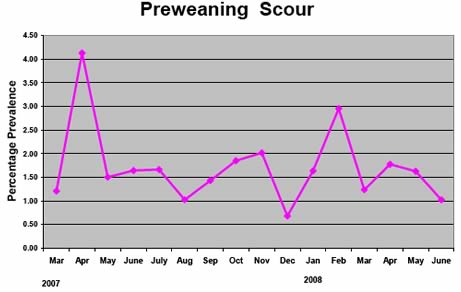 |
|||||||||
|
|||||||||||||||||||
|
|
NADIS Health Report for June 2008 16/07/08 The National Animal Disease Information Service (NADIS) is a veterinary based clinical reporting and surveillance system based upon veterinary surgeons on farm visits. As well as recording anecdotal remarks on health issues (summarised in the monthly NADIS report), production and health data is also collected. With a shortage of slaughter pigs available and prices finally beginning to move substantially, veterinary surgeons visiting pig farms are detecting more optimism in the industry. Provided the expected health improvements in growing pigs occur as a result of the widespread application of Circovirus vaccination the prospects in the near future are encouraging not withstanding high food prices. Sows Few reports of specific management related fertility problems were received and a number of comments suggest that recent performance has improved but with the risk of excessive pressure on farrowing space. Occasional producers are beginning to return to a mixture of boar plus AI serving after prolonged periods and disappointing results for pure AI use, although the specific reasons for poor results has not been detailed. Health problems dominated the reports of adult stock:
Piglets Unusually very few reports highlighted piglet scour problems although background disease persists.
Mortality problems outdoors were highlighted with fox predation, lameness in sows and mismatching in group farrowing systems, all believed to be contributing to piglet losses.
Weaners There were widespread reports of disease in weaners although in the last few months the reports of non specific scour and ileitis beyond the immediate post weaning phase have been sparse. Overstocking, usually as a result of excessive sow production is frequently highlighted as a contributory factor to respiratory disease and PMWS. In addition, fading of pigs after weaning as a result of weaning them too early (to create room for the next farrowings) was identified. A general observation is that the early results of PCV2 vaccination are encouraging with health and condition of weaners better and growth more even. Occasional reports were received of minor reaction to piglet vaccination (particularly vomiting and temporary collapse) but deaths have not been reported. With wholesale vaccination still in its early days, it is important that as much information – both good and bad – is collected. Peri-weaning coughing was seen and remains a somewhat frustrating condition although often not having a noticeable effect on overall piglet quality. PRRS associated respiratory disease, Greasy Pig Disease and post weaning meningitis all featured with the latter 2 conditions being frequently associated with high humidity. Growers and Finishers The drop in prevalence in grower scour continues to feature prominently in vets anecdotal remarks as does general discussion of the expected benefits of Circovirus vaccination. It is still too early in many farms to gain a satisfactory picture of improvements post vaccination but of concern are a few preliminary remarks on farm suffering late onset PMWS and grower PDNS following vaccination of the breeding herd. Overstocking is regularly blamed for disease problems especially respiratory disease and. PMWS but in one case introduction of enzootic pneumonia vaccine led to a sharp fall in mortality, suggesting a significant contribution of Mycoplasma hyopneumoniae to the previous complex of respiratory disease. Actinobacillus pleuropneumonia continues to feature sporadically – in one case rather worryingly an outbreak resulted from introduction of infected replacement gilts. Isolation/quarantine and testing of incoming stock remains key to preventing disease introduction. Early reports are being received of fly bite lesions, particularly in straw yard pigs. This condition seems to have become more of a problem in the last 2-3 years and if present at slaughter can be costly – due to skinning and down grading. Skin disease associated with Staphylococcal infection (Greasy Pig Disease) was also noted unusually in finishing pigs. Comments were made of increasing prevalence of Erysipelas in growing pigs – usually vaccinated – and may reflect changing housing patterns and altering climate. Sudden deaths associated with twisted guts (usually referred to in SW England as Whey bloat) were identified as a particular problem in fast growing pigs. A final comment relates to difficulties arising from Food Chain Infestation reports that are contradictory to BPHS abattoir assessments – often on the same batch of pigs. It will be no surprise that veterinary surgeons are tending to encourage clients to ignore FCI reports in such situations, having greater confidence in the veterinary surgeons assessments under the BPEX scheme. Mark White BVSc DPM MRCVS
|
||||||||||||||||||

|
|
||||||||||||||||||
| home | agri-services | pedigree
pen | news | dairy | beef | machinery property | organisations | site map |
|||||||||||||||||||

